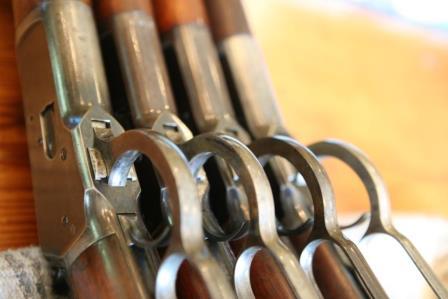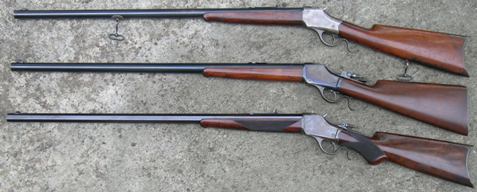Hello,
The nomeclature is derived from the first number being the caliber, or diameter, of the projectile and the second being the weight in grains of black powder used for a standard load. BUT, the 38 is actually .401 caliber.
Michael

Model 1892 / Model 61 Collector, Research, Valuation
Bert is correct; however, you may also hear that the 38-40 was originally loaded with 40 grains. What gives? My reproduction of the December 1896 Winchester catalogue lists both, the W.R.A.Co. Winchester cartridge and the W.R.A.Co. Marlin cartridge.
Winchester’s cartridge: Designated in the catalogue as ‘.38 Winchester’ with ‘W.R.A.Co. 38 W.C.F.‘ stamped on the base of the cartridge; 38 grains under a 180 grain pure lead bullet. The notation under this cartridge in the catalogue says, ‘Adapted to Winchester Repeating Rifles, .38 Caliber, Model 1873 and Model 1892, and Winchester Single Shot Rifles’.
Winchester’s ‘Marlin’ cartridge: Designated in the catalogue as ‘.38-40-180 Marlin Safety’ with ‘W.R.A.Co. 38-40‘ stamped on the base of the cartridge; 40 grains under a 180 grain pure lead bullet. The notation under this cartridge in the catalogue says, ‘Adapted to Marlin and Winchester Repeating Rifles’.
Incidentally, the December 1896 Winchester catalogue also lists a smokeless version of the ’38 Winchester’ WHERE post_id = using 16 grains of smokeless powder under a 180 grain jacketed bullet (full metal or soft point). Looking at my own experimentation with various smokeless powders, I get the following results with cast bullets:
16 grains 2400: 1,502 fps
16 grains 5744: 1,146 fps
16 grains IMR SR4759: 1,035 fps
This suggests that the original Winchester smokeless powder, which gave a velocity in the neighbourhood of just over 1,300 fps (or 1,268 fps 50 feet from the muzzle), had a burn rate slower than 2400 but slightly faster than 5744. I’m assuming no filler was used.
This is different from most of the old Winchester cartridges.Which had the calibre ,then load of black powder in grains and then grain of the bullet.
For example .45-70-405 means .45 calibre,70 grains of black powber and a 405 grain bullet.
The story told in years gone by was that the .38-40 ,using a .40 calibre bullet should have been called the .40-40 Winchester .However Winchester did not want to do this as they thought it would be confusing with the .44-40 already in the line.Therefore they called it a .38 calibre when it really was not.
As to Winchester contemplating the 40-40 moniker, I have heard it many times before and do not believe it…..Winchester came up with these rounds so they were proprietary…To Winchester it was the 38 W.C.F., Plain and simple. there was the .32 W.C.F and the .44 W.C.F. When these rounds became popular enough that Colt and Marlin could hardly avoid Chambering them the last thing they wanted to do was attach the Winchester name to the Barrel of their guns! It was these competitors that renamed them the .32-20, .38-40, and 44-40…Winchester resisted this for a long time and it wasn’t until much later, when the buying public became ingrained with the new monikers that Winchester [reluctantly I would guess] began to refer to them as .38-40 etc on their cartridge boxes…correct me if I am wrong..Brian
I infer from the reproduction of the December 1896 catalogue that the ’38’ stands for some approximation of the caliber. My basis for this is that in the cartridge section, they refer to it as being adapted to the ‘.38 caliber, Model 1873 and Model 1892′. Strictly speaking, they never made a ’38 caliber’ in either of these models. The caliber was actually 40.
First off the 45-70 was not a Winchester cartdridge. The designation
of the caliber- powder dates back further than the 44WCF. It would be
very hard or maybe impossible to determine who started this practice.
The 44-60 Sharps dates back to 1869 four years earlier than the 44
WCF./ It is interesting that the Winchester 1896 catalog list the Model
1873 in 32,38 and 44 calibers. The Model 1892 was listed in 25,32,38
and 44 calibers. It leads one to think that whoever was in charge of
the writing of the catalog did not know the difference. In the several
years of a lot of reading I have never read or come up with anything
in my own thinking that made sense. This may very well be one of those
question’s or at least for the time being that simply can’t be answered.
I believe the 44WCF designation was given to the cartridge that was originally called The Model Of 1873. I’m not certain when it changed, officially. Anyone have that date? I remember reading that the 38WCF was named, in part, to attract sales from that group of gun buyers that were already in preferance to upper 30’s calibers. No different than today. Marketing.
Gobbler
Come to think of it, there are a few other cartridges where the bullet diameter (or groove diameter) did not match the number. Rounding off to the nearest integer ….
The 38 WCF is really a 40 caliber
The 44 WCF is really a 43 caliber
The 45-70 is really a 46 caliber
The 32 WCF is really a 31 caliber
I am doubtful that it was the writers of the catalogues who added the ‘caliber’ designation. All I can put it down to is artistic license on the part of Winchester and other gun manufacturers.
It is similar to the way automobile manufacturers round up the displacement of the engines. For instance the 5 liter engine in a Ford Mustang actually has a displacement of 4,951cc! The "5.7" liter ram truck engine is actually 5654 cc of displacement. I guess the "impression" of BIG size is important to some.
Michael

Model 1892 / Model 61 Collector, Research, Valuation
Win38-55 said
Come to think of it, there are a few other cartridges where the bullet diameter (or groove diameter) did not match the number. Rounding off to the nearest integer ….The 38 WCF is really a 40 caliber
The 44 WCF is really a 43 caliber
The 45-70 is really a 46 caliber
The 32 WCF is really a 31 caliberI am doubtful that it was the writers of the catalogues who added the ‘caliber’ designation. All I can put it down to is artistic license on the part of Winchester and other gun manufacturers.
To be just a bit more precise;
38 WCF = .401 (40 rounded)
44 WCF – .429 (43 rounded)
45-70 = .457 (46 rounded)
32 WCF – .319 (32 rounded)
Bert
WACA Historian & Board of Director Member #6571L

There are actual differences when examine closely between the 38-40 Marlin Safety and (38W.C.F.)38-40 Winchester. The Marlin round had a smaller primer and a different shaped and composition bullet.
Maverick
![]()
WACA #8783 - Checkout my Reloading Tool Survey!
https://winchestercollector.org/forum/winchester-research-surveys/winchester-reloading-tool-survey/
maverick said
There are actual differences when examine closely between the 38-40 Marlin Safety and (38W.C.F.)38-40 Winchester. The Marlin round had a smaller primer and a different shaped and composition bullet.Maverick
If you put an original 38 WCF black powder cartridge alongside a later 38 WCF smokeless powder cartridge, I believe that you will find that the primer is smaller in diameter on the latter cartridge.
Bert
WACA Historian & Board of Director Member #6571L

There is a two-volume set titled "W.R.A.Co.: Headstamped Cartridges and Their Variations" by Daniel L. Shuey that explains Winchester ammunition production in great detail. The differences between the Winchester and Marlin versions and the variations in primer size are explained, as are many other details.
IIRC, I bought both volumes from Buffalo Arms a couple of years ago. Somewhat pricey, but I have paid more for collector books that proved to be of far less value.
Bert H. said
To be just a bit more precise;38 WCF = .401 (40 rounded)
44 WCF – .429 (43 rounded)
45-70 = .457 (46 rounded)
32 WCF – .319 (32 rounded)
I am wondering about that 32 WCF dimension. I have a drawing of the 32 WCF cartridge and chamber dimensions. According to that drawing, the bullet diameter is to be .3095-.3125. The groove diameter is to be .311 – .313. This drawing is dated 1986, so earlier dimensions may have been larger. I have a Model 53 chambered in 32 WCF and barrel stamped ’29’ that has a slugged groove diameter of .3105". However, I did have a Model 1892 32 WCF made in 1903 that had a slugged groove diameter of .3135. Even then, .319 seems pretty large. I’ve never heard of a 32 WCF that large. On the other hand, I’ve no experience with the bores of Model 1873’s chambered in 32 WCF. Maybe those were larger?
In general, I have slugged quite a few Winchester bores. I find that the 38 WCF groove diameters are pretty much bang on at .401 as Bert pointed out. Same goes for the 45-70 groove diameters, which always seem to be .457". On the other hand, the 44 WCF Winchester groove diameters seem to be all over the map, as are the 38-55 groove diameters. The smallest groove diameter for the 44 WCF that I have slugged is .429. My original Model 1873 made in 1889 has a slugged groove diameter of .432. Soft cast bullets sized to .431 (the max size my ’73 will chamber), however, do bump up to fill the bore and give outstanding accuracy. I once owned another ’73 made in 1878 that had a slugged groove diameter of .433. My 38-55’s slug at anywhere between .3795 (my current one made in 1897) to .383 (made in 1899).
My drawing for the 44 WCF cartridge and chamber dimensions shows the bullet diameter is to be .4240 – .4270 and the groove diameter is to be .4285 to .4305.
My drawing for the 38-55 cartridge and chamber dimensions shows the bullet diameter is to be .3740-.3770 (this must be jacketed! a cast bullet that small would lead the bore up in no time flat) and the groove diameter is to be .379-.381.
All these drawings date to 1986, so they may not be indicative of earlier drawings and dimensions.
1 Guest(s)


 Log In
Log In Members
Members Home
Home

 Add Reply
Add Reply Add Topic
Add Topic Offline
Offline





